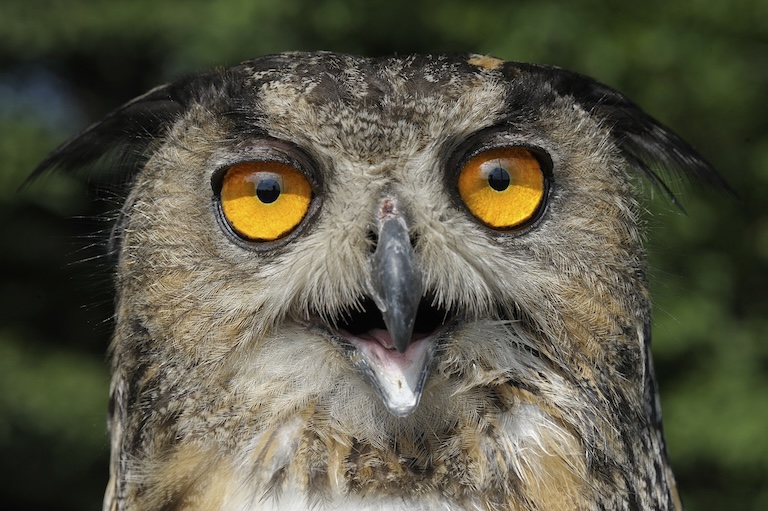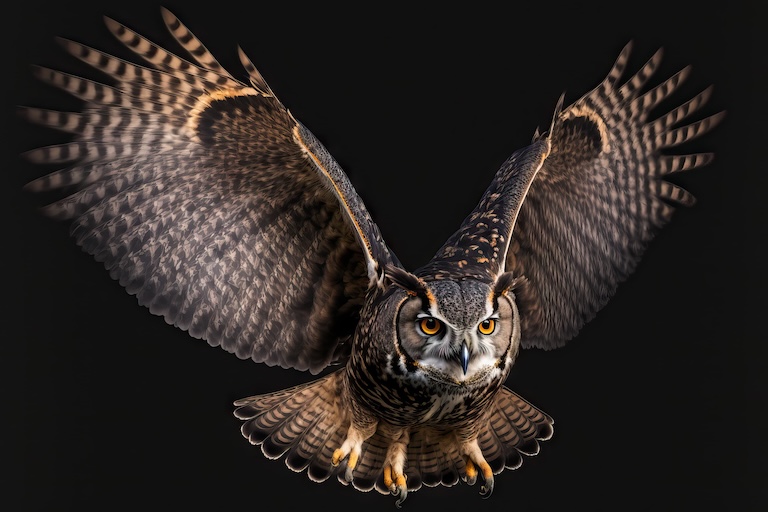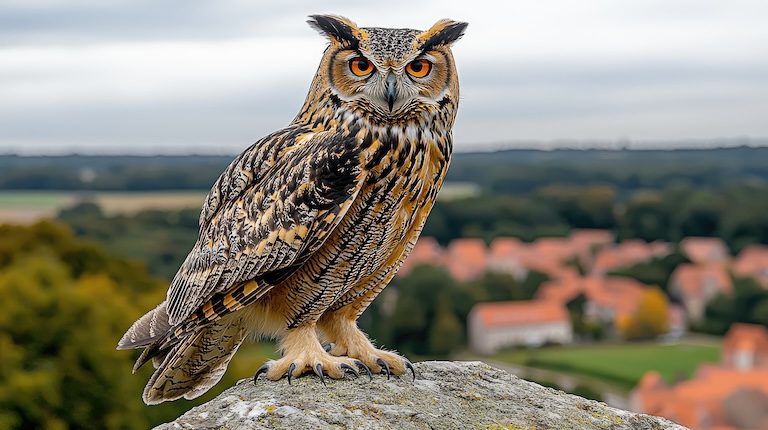Eurasian Eagle Owl Profile
There’s a strange natural law that the pretty animals are so often the least mentally stimulating.
Of all the birds, Owls are some of the most impressive to look at, and of all the owls, eagle owls have some of the most formidable presence.
It’s fitting, then, that the Eurasian eagle owl is the world’s owlest owl, complete with a characteristic hoot, murderous intent and the cognitive power of a non-Newtonian fluid.

Eurasian Eagle Owl Facts Overview
| Habitat: | Varied woodland, rural to urban areas |
| Location: | Widespread across Eurasia |
| Lifespan: | Up to 20 years |
| Size: | Wingspan up to 190 cm (75 inches) |
| Weight: | Up to 4.6 kg (10.1 pounds) |
| Colour: | Mottled grey with white and buff |
| Diet: | Opportunistic predator of mammals and birds |
| Predators: | None |
| Top Speed: | Unknown |
| No. of Species: | 1 |
| Conservation Status: | Least Concern |
Eurasian eagle owls are as big as they come. These are formidable raptors, nocturnal hunters of our warm-blooded, ground-dwelling relatives.
These stunning birds have recognisable orange eyes and peculiar tufts that look like ears but aren’t.
They’ve had their share of persecution by humans, but the species as a whole is so far doing okay, and with a little luck, they’ll continue to do so.
Interesting Eurasian Eagle Owl Facts
1. They can weigh up to 4kg!
The first thing worth mentioning about these owls is just how large they are. For a flying bird, a mass of up to 4kg is quite significant, especially when you consider that owls are 100% feathers.
Eagle owls are part of the Bubo genus, with some of the other heavyweights of the owl family. Their wingspan reaches to almost two meters across, and they come in a range of colours, but they all carry the characteristic tufts and smouldering, orange glare.
2. They sound like an owl
They sound the part, too.
The classic “Twit-Twoo” of your stereotypical owl is the call of just one species, the Tawny owl. And it’s actually to owls, engaged in a male-female call and response. The female is the “twit”, and the male responds with a “hoo-hoo”.
Owls in general often don’t sound as you’d expect; ghost-like barn owls sound more like a screaming rodent, barred owls sound like a pigeon, and burrowing owls make a little trumpet noise that’s more like a cartoon mouse from ‘60s kids’ TV.
But Eurasian eagle owls are the largest owls and are therefore ambassadors for the owl family, and so they must have a very owl-like sound. Males make a loud booming call, instantly recognisable as an owl.
The females give off a much harsher scream in return, much in the way Tawnies duet, and these differences allow researchers to tell them apart. But these calls are also unique enough to individuals that each bird can be recognised by its call. 1

3. They’re silent
Of course, it doesn’t bode well for an ambush predator to make a lot of noise, and most of the time these birds are deathly quiet.
Not only do they keep their mouths shut, but their entire bodies are designed to limit sound. The morphology of owl feathers is specifically evolved to dampen noises, with special microstructures that can only be seen. Under a microscope.
They are stiff and strong, but being so perfectly designed, they are also delicate and will become damaged over time. The feathers are shed periodically and replaced as they become worn. 2
4. They eat anything
This well-oiled machine is perfectly designed for killing mammals, and that’s what these owls do best.
Just under 84% of prey in one population in Romania was determined to be mammalian, mostly rodents, and almost 16% were other birds. The remaining outliers were arthropods and lizards, but these made up less than 1%.
Rats and hamsters appear to be the most popular, but this shows that the owl is adaptable and opportunistic, and therefore can likely exploit species across a wide range of environments. 3
5. They have distinctive, orange eyes
One of the most striking features of these enormous birds is the piercing glare from its huge, orange eyes.
This colouration might give a suggestion as to what time the animal hunts, as there appears to be a correlation between crepuscular (active during dawn and dusk) animals and the orange (or sometimes yellow) eyes of a vampire from Buffy. 4
6. And ear tufts
Their ear tufts aren’t ears at all, and it’s not clear exactly what they’re for, other than general majesty.
It’s thought they might play a role in communication or identification. Most tufted owls live in forests, whereas open-area owls like the [barn owl] have rounder heads.
Having some distinctive ear tufts might make it easier to distinguish the owl from the trees when looking for a mate or for young, trying to keep up with their parents.
On the other hand, they could also act to disrupt the owl’s silhouette, providing camouflage among the branches. So far, their true nature remains a bit of a mystery. 5
7. They were persecuted
This is one of the species that suffered tremendously from persecution in the 20th century. Pesticide use made things worse, as did vehicle collisions and barbed wire. Diseases like myxomatosis wiped out prey species in many locations, and the ever-encroaching nature of human agriculture fragments and destroys habitats.
But the species has proven to be resilient, and they’ve bounced back in response to protections and reintroduction programs. The species still benefits from legal protection and is highly regulated in its trade.
But power lines are still a major issue. 6
8. They’re often electrocuted
Electrocution has led to many reductions in the population of eagle owls in Europe. It’s still a major cause of death among individuals of the species, and this disproportionally affects youngsters just beginning to disperse.
Where this is a common risk, abandonment sometimes occurs, where populations will leave the area entirely. It was estimated in one study that 17% of newly-fledged eagle owls were lost to electrocution. 7

Eurasian Eagle Owl Fact-File Summary
Scientific Classification
| Kingdom: | Animalia |
| Phylum: | Chordata |
| Class: | Aves |
| Order: | Strigiformes |
| Family: | Strigidae |
| Genus: | Bubo |
| Species: | Bubo |
Fact Sources & References
- THIBAULT GRAVA (2007), “Individual acoustic monitoring of the European Eagle Owl Bubo bubo”, Wiley Online Library.
- “The Sound Suppression Characteristics of Wing Feather of Owl (Bubo bubo)”, Springer Link.
- Attila D. SÁNDOR (2009), “Diet of the eagle owl (Bubo bubo) in Braşov, Romania”, Bio Zoo Journals.
- “EURASIAN EAGLE OWL”, Wild Life Images.
- Dan Gleason “Owl’s Ears”.
- “Eurasian Eagle Owl”, Highland Wildlife Park.
- FABRIZIO SERGIO (2004), “Electrocution alters the distribution and density of a top predator, the eagle owl Bubo bubo”, British Ecological Society.
